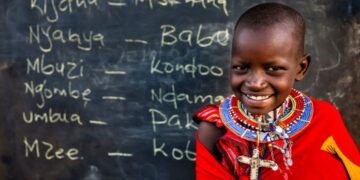The inscription of tribal marks serves different purposes across many African ethnic groups. These purposes include beautification, identification, and spiritual protection as the case may be. Although the practice is adjudged barbaric and unhealthy in modern times due to the way and manner it is conducted, tribal marking or scarification is still being practiced by some ethnic groups across the African continent.
While scarification is known to predate the invasion and annexation of Africa by the Western European powers, European slave raiders leveraged a similar practice; involving the cutting and perforation of body parts of their slaves. This helped them to distinguish their captives and also identify them if they escaped.
Interesting Facts About African Tribal Marks That You Should Know
1. Tribal Marks Helped Repatriated Slaves to Reunite with their Communities During the trans-Atlantic slave trade
While it has already been established that the Euro-American slave trade leveraged scarification in distinguishing the captives of slave owners, the initial tribal marks that the 16th to 19th-century slaves wore helped them in locating and reuniting with their families and communities after their repatriation following the abolitionist’s movement in the 20th century.
2. Scarification has been in Existence for Hundreds of Years
Although there are divergent views regarding the history of tribal marks or scarification in Africa, no one can dispute the fact that the practice predates the invasion and annexation of the continent. Surprisingly, the significance of the practice is nearly identical across many ethnic groups throughout Africa.
For instance, some ethnic groups in countries like Ghana, Nigeria, and South Sudan believe that tribal marks are significant in beautification and identification during wars. They also believe that the practice helps to trace a person’s tribe and family while checking incidents of incest and intra-family marriage.
Although with minor modifications, these beliefs are similar to countries like Ethiopia, the Democratic Republic of Congo, the Benin Republic, and Tanzania.
3. Tribal Marking is Used to Celebrate the Onset of Puberty In Some Parts of Africa
4. It is Alleged that Tribal Marks Keep Mischievous Children Alive
The Yoruba people of South-Western Nigeria are one of the most recognized with tribal marks in Africa. Aside from the functions of identification, and beautification as stated earlier, this ethnic group believes certain marks help in keeping mischievous children alive. These types of children are called Ila Abiku.
Ila Abiku refers to a child who dies before reaching puberty and returns to the same mother multiple times to be reborn over and over again. In such cases, it is believed that the spirit that lives in such a child is indifferent to the plight of its mother and possesses the Abiku spirit. Hence, certain tribal marks are made on such a child to keep him or her alive.
Similarly, the Igbo ethnic group of South Eastern Nigeria sometimes administers marks on children referred to as Ogbanje; meaning evil child. Specific tribal marks on the Ogbanje are believed to deter such a child from tormenting his parents by being born over and over again just as in the case of Abiku.
5. Some African Tribal Marks Cure Certain Ailments
6. It is used to Reflect Position or Royalty
The practice of tribal marking is significant in showing the position of a particular child in the family in some ethnic groups. For instance, the Oyo people of Western Nigeria give tribal marks to every firstborn regardless of sex.
More so, the Mossi ethnic group of Burkina Faso used to have a special tribal mark for the royal family. The Royal Family’s tribal mark consists of three lines that start near the jawline tracing the shape of the face to the other side of the mouth.
Similarly, tribal marks are associated with the throne in Iseyin, Oyo State. Consequently, anyone who becomes king in the community is expected to have the Pele tribal mark.
7. The Process is Often Long and Painful
African tribal marks may appear beautiful to those who care. However, the processes of acquiring such marks are usually long, extreme, painful, and unhealthy in most cases.
Depending on the ethnic group, the process usually involves the use of knives, broken bottles, thorns, and stones to make mutilations, and perforations on a small or large space on the human body.
In some climes, scarification is done by burning or slicing the skin with a razor blade. By the time the skin is sliced, funny elements like ash, sand, or natural herbs are applied in order to inflame the cut enough to swell up significantly.
More so, the process is usually conducted by individuals who do not have any prior medical knowledge. Meaning they can hardly administer any sort of analgesic to reduce the pain of their victims. They also use unsterilized tools that may transmit diseases like tetanus hepatitis B and HIV AIDS according to experts. Moreover, other effects of the practice include skin cancer and permanent discomfiture.
Unfortunately, because of the crude and unhygienic manner in which tribal marks are administered, several victims experience blood loss and in some instances, death. Furthermore, medical experts have alleged that many children have died during the process.
8. African Tribal Marks May Cause Trauma and Social Stigma
While there are known physical consequences regarding tribal marks, the practice also has a long psychological, emotional, and social effect on the victim. As you may likely find, children and teenagers who were marked from childhood usually face a lot of jeer, mockery, and ridicule from their peers or even other members of society which leads to low self-esteem.
In most cases, people use their appearance to pick on them or make expensive jokes that may just be too humiliating and dehumanizing. With these and more, there is every likelihood for such persons to slide into depression or develop other forms of mental illness.
9. Many African Tribes Have Abandoned the Practice
10. It is Termed ‘Pagan Practice’ in Some African Societies
It is no longer news that the use of tribal marks is drastically fading away in several African ethnic groups. This is propelled by the agitations of victims who evolved to indict their parents or caregivers for modifying their bodies without their consent. Furthermore, the influence of religion is also a major factor in abating the practice which is now termed ‘pagan.’
Meanwhile, several state legislators have passed laws and regulations banning the marking of any child; describing the act as child abuse. Notwithstanding, there are individuals who still believe that tribal marks are one of the best ways Africans can sustain their culture and values.




















